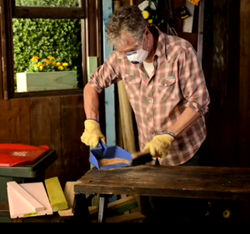When planning a new project
- Do your research and choose the safest treated timber for the job with the lowest hazard levels possible.
- Look at alternatives to timber. There are now new materials such as recycled plastic on the market that look like timber but do not contain as many hazardous chemicals.
- Make sure you have the right screws, nails, bolts, brackets or other fastening hardware for the job.Some timber treatments, particularly copper based treatments, can corrode steel fasteners. Fasteners in contact with preservative-treated pine should be: hot-dipped galvanised; monel; silicone; bronze or stainless steel. Electroplated fasteners are not suitable due to early break down of the plating.
- Some treated timber types need cut surfaces resealed to make sure the treatment envelope is maintained. Ask at a hardware store if you are not sure which sealant to use.


